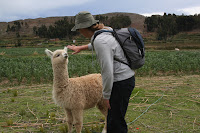Well...we've lost another good camera out here on the road. Here's what happened...
To catch you up, I broke my camera in the Galapagos so Brandon sprung for a new camera when we were in Lima. Hence, the camera was only about 2 weeks old.
We were on a bus heading from
Cusco, Peru to
Puno, Peru which is on Lake
Titicaca and the Bolivian border. The ride takes about 7 hours and winds through the Andes mountains.
Because the road was quite curvy, baggage tended to shift a bit.
Brandon had put his small backpack between his feet, but we both fell asleep pretty soundly. With the excessive twisting and turning his backpack moved around a bit, but it was still in contact with our feet.
Turns out we must have been much more comatose than we thought. We made a stop in a town about 45 minutes outside of our destination when Brandon had a weird feeling about the position of the bag. He started fishing through the backpack only to find that the new camera and both battery chargers and batteries had been lifted (we still had the chargers and batteries from my broken camera).
I quickly ran to the front of the bus to inform the bus driver and attendant that we had been robbed, but, in so many words, they told me that I was shit out of luck. Whoever, had taken the camera was long gone.
Luckily, the
perpetrator had only gotten
a hold of our camera equipment, but, no matter how many times we've been robbed, the initial realization that something is missing SUCKS.
To add insult to injury, the next day on our way from
Puno, Peru to Copacabana, Bolivia which sits on the other side of Lake
Titicaca we noticed that our traveler's checks had been lifted off of us. We figure it happened in our hostel in
Cusco because if the
thief on the bus from the previous day had gotten into my backpack, my
wallet would have been long gone.
Anyhoo, we're thinking that the cleaning boy from the hostel in
Cusco liberated us of our traveler's checks because he would "do us the favor" of organizing our belongings everyday. While we were pissed that the guy stole from us, we weren't too worried about it
because it's usually pretty difficult to cash traveler's checks in foreign countries...you usually need a passport as well as a matching signatures. Well, turns out that's not the case in Peru...
When we called from La
Paz, Bolivia to report the checks stolen we found out that Brandon's checks had been cashed...he has to wait four weeks while an investigation regarding his stolen checks ensues. Fortunately, I was able to pick up new traveler's checks in La
Paz and the lady at the office informed us that it's actually really easy to get traveler's checks cashed in Peru...so easy that most Bolivian thieves cross the border to cash their stolen traveler's checks. Convenient, huh?
To top it all off, we arrived in Copacabana, Bolivia with minimal cash because we were planning on taking money out of an ATM or from a bank. We decided this would be the best course of action because there is a huge problem with counterfeit bills in Peru. Another interesting point...the money changers on the borders tend to have plenty of these fake bills.
Well, this ended up biting us in the butts because we arrived on Saturday assuming (yes, it does make an ASS out of U and ME) that the banks would open on Monday morning. While we had enough to get through the weekend, we REALLY needed to get to the bank bright and early Monday morning.
Turns out...the bank in Copacabana is closed on Mondays and Tuesdays. Makes perfect sense! We toured the small town to see if the two hotels that actually accept credit cards could give us a cash advance. No luck...we
could've really used our stolen traveler's checks right about now.
Thank goodness we were with our very prepared South African friend who was able to spot us some cash until we could get to an, OPEN, bank.
 While eating lunch at Iguazu Falls, this beautiful bird came and perched in the tree next to us. We figured he was getting into position for the leftover bread crumbs or pototo chips, but when the people next to us abandoned their lunch trays...
While eating lunch at Iguazu Falls, this beautiful bird came and perched in the tree next to us. We figured he was getting into position for the leftover bread crumbs or pototo chips, but when the people next to us abandoned their lunch trays... the bird went straight for the mayonaise packets...nothing else. I guess the Atkins diet works for birds too.
the bird went straight for the mayonaise packets...nothing else. I guess the Atkins diet works for birds too.



























